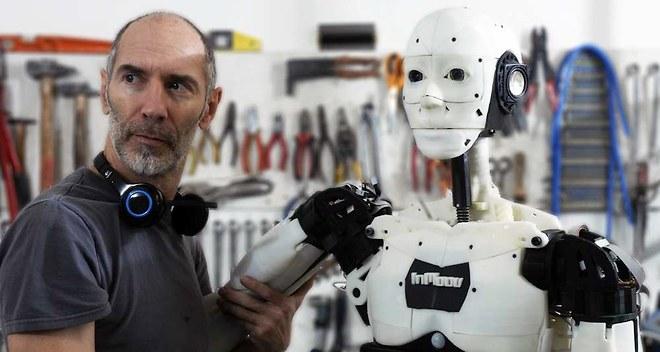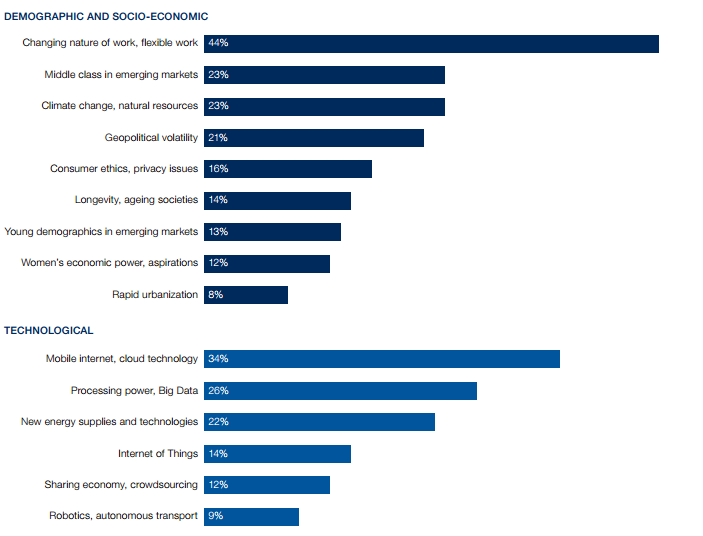World Economic Forum Report: Existing Workforce Must Prepare, Re-Skill & Up-Skill for Impending Fourth Industrial Revolution
 “If every tool, when ordered, or even of its own accord, could do the work that befits it… then there would be no need either of apprentices for the master workers or of slaves for the lords.” – Aristotle
“If every tool, when ordered, or even of its own accord, could do the work that befits it… then there would be no need either of apprentices for the master workers or of slaves for the lords.” – Aristotle
Humans have such a love/hate relationship with technology that it’s almost comical. All of our own creation, once we’ve perfected amazing innovations, we often turn on them–when convenient. As the PC became common and marketed toward the masses in the 80s, a new world of automation, both good and bad, was predicted. As mad scientists tucked away in secret, underground labs began creating evil robots in a slew of sci-fi movies that we consumed greedily, along with becoming affectionate toward machines like C-3P0 and R2-D2 just birthed in what would be a continuing pop subculture with a momentum of its own, our imaginations ran wild. Fearmongers cited that automation would make many jobs obsolete; robots would begin doing what was left as an economic apocalypse ensued for the human race.
In truth, the birth of the computer created a huge industry of jobs, from manufacturing and maintenance to advanced software engineering and entire IT departments. And although it’s been predicted through the ages that robots would begin doing all of our tasks, how many of us are actually employing robots in the home or office–and how many people do you know who lost their jobs because it was given to a humanoid instead? Probably none. But still, yes, there are whispers saying that may change one day soon. And while we’ve all heard that talk for decades past, it is undeniable that innovation on nearly every level has been accelerated recently, and is predicted to continue as 3D printing, artificial intelligence, and robotics evolve–just as a few examples.
A recent report by The World Economic Forum is ‘a call to action’ that indicates that we are headed into a new era, and one for which those in the workforce should indeed prepare. It’s also important to note that their research states how diverse expert views are on the whole topic of job security and transformation.
“Today, we are on the cusp of a Fourth Industrial Revolution. Developments in genetics, artificial intelligence, robotics, nanotechnology, 3D printing and biotechnology, to name just a few, are all building on and amplifying one another. This will lay the foundation for a revolution more comprehensive and all-encompassing than anything we have ever seen,” states the research indicated in ‘The Future of Jobs.’
“Disruptive changes to industry sectors are already re-configuring business models and skill sets—and will do so at an accelerated pace in the next five years.”
It’s not a foreign idea to consider that children in elementary school today will probably grow up to have job descriptions that did not exist when we were considering the question of ‘what do you want to be when you grow up?’ As needs within manufacturing and the computer industry change, the skillsets being taught in schools are beginning to reflect that, and will continue to do so.
“In many industries and countries, the most in-demand occupations or specialties did not exist 10 or even five years ago, and the pace of change is set to accelerate,” the report states.
“By one popular estimate, 65 per cent of children entering primary school today will ultimately end up working in completely new job types that don’t yet exist.”
The STEM (science, technology, engineering, mathematics) agenda has indeed begun to infiltrate many classrooms, libraries, and labs. The power of 3D printing has been monumental in attracting enthusiasm–often beginning with teachers and university professors who are experimenting with the technology themselves first–and with vision for the future, they begin to lobby for labs within their own learning institutions. The result is that students are indeed now beginning to graduate with skillsets needed to fill empty slots in thousands of jobs. These graduates (and dropouts) are also going on to create progressive startups, and a complete transformation in the office culture as well, with tee shirts, well-worn jeans, and high tops as the new dress code–and many never showing up to a formal office at all, but working from home–and that has growing economic implications in itself.
The report makes it clear, however, that we can’t simply wait for all the kids to come up through the ranks and graduate with the skills needed:
“To prevent a worst-case scenario – technological change accompanied by talent shortages, mass unemployment and growing inequality – reskilling and upskilling of today’s workers will be critical,” the authors said. “It is simply not possible to weather the current technological revolution by waiting for the next generation’s workforce to become better prepared.”
Not digging from a small pool, the research from World Economic Forum came from a worldwide survey that gleaned information from 13 million employees working in nine different industries from the following countries: Australia, Brazil, China, France, Germany, India, Italy, Japan, Mexico, South Africa, Turkey, UK and US, plus the Association of South East Asian Nations (ASEAN) and the Gulf Cooperation Council (GCC).
“A quarter of the companies surveyed employ more than 50,000 people globally; another 40% have between 5,000 and 50,000 employees; the remaining third is equally split between employers with 500 to 5,000 staff and high-growth companies with currently up to 500 employees,” states the report data.
Ironically, it seems that the more automation we create and the more conveniences we work to install in our lives, the more complicated things become–and the more jobs that are created around fixing and maintaining those complications, as well as improving them continually. From this, new industries and micro-economies continue to evolve, and as the report from the Forum indicates, many of our own jobs will probably exist, but as is usually the case–they will change.
“While some jobs are threatened by redundancy and others grow rapidly, existing jobs are also going through a change in the skill sets required to do them,” states the report. “The debate on these transformations is often polarized between those who foresee limitless new opportunities and those that foresee massive dislocation of jobs. In fact, the reality is highly specific to the industry, region and occupation in question as well as the ability of various stakeholders to manage change.”
The message would definitely seem to be that we all need to roll with the punches, stay informed, and keep learning. If you are just entering the workforce or have many years ahead of you, this certainly is not a good time to put your feet down and start rebelling against the digital age–especially as technologies like 3D printing offer us such an expansive new world to explore–and from which to innovate. The World Economic Forum’s data seems to reflect positively on that note, offering that it should offer a better effect on the workforce, and allow humans to reach their potential, rather than ending up homeless and living in their cars as many extremists would like us to envision. And as the story has gone now for decades, robots are clearly not ready to take over the world. Yet.
It’s obvious that a plethora of positive effects already are and will be felt around the globe as we use a range of different smart systems to make the world a better place from home to business to worldwide industry and implementing major solutions to continually looming environmental concerns.
Change does have a way of invoking both excitement and fear–and that always seems to translate to technology quite predictably also. The bottom line is that we are advancing quickly, and the times are as they famously say–still changing. It would seem that the best course of action is to keep learning and embrace all that this new and emerging digital frontier encompasses. What do you think of the data in this report? Discuss in the World Economic Report Sees 3D Printing as Positive forum over at 3DPB.com.
Subscribe to Our Email Newsletter
Stay up-to-date on all the latest news from the 3D printing industry and receive information and offers from third party vendors.
You May Also Like
3D Printing News Briefs, April 13, 2024: Robotics, Orthotics, & Hypersonics
In 3D Printing News Briefs today, we’re focusing first on robotics, as Carnegie Mellon University’s new Robotics Innovation Center will house several community outreach programs, and Ugogo3D is now working...
Rail Giant Alstom Saves $15M with 3D Printing Automation Software 3D Spark
3D Spark has entered into a three-year deal with the rail giant Alstom. Alstom, a transport behemoth with annual revenues of $16 billion, specializes in the manufacture of trains, trams,...
Meltio Expands Global Reach with New Partnerships in the Americas and Europe
Spanish 3D printing manufacturer Meltio has expanded its sales network across the globe. With the addition of three new partners in the United States, Brazil, Argentina, and Italy, Meltio aims...
3D Printing Webinar and Event Roundup: April 7, 2024
Webinars and events in the 3D printing industry are picking back up this week! Sea-Air-Space is coming to Maryland, and SAE International is sponsoring a 3D Systems webinar about 3D...



































